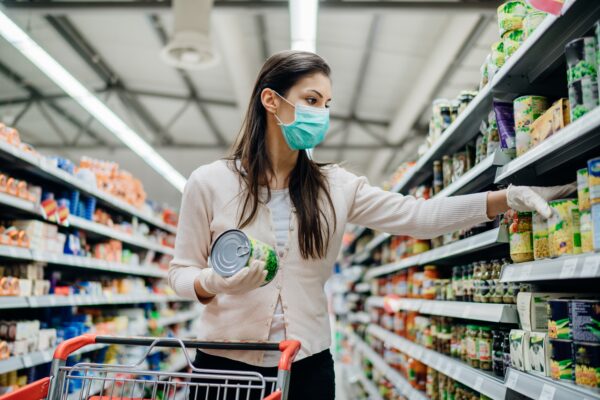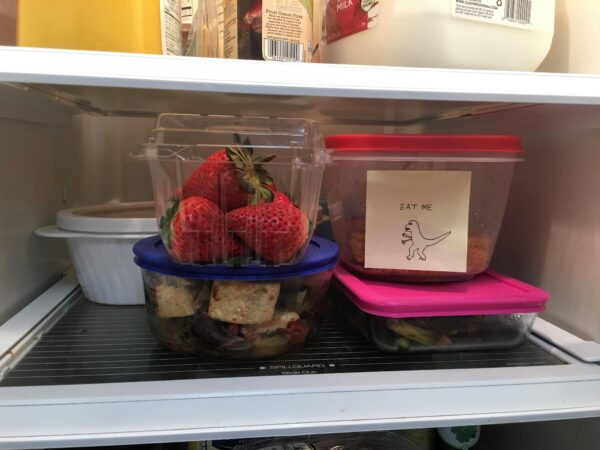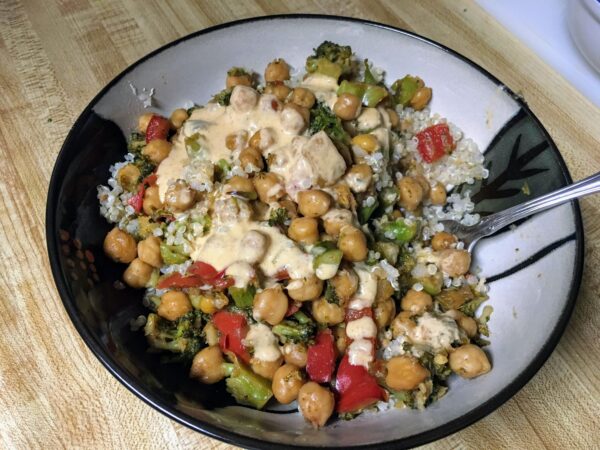With the current COVID-19 public health crisis, many people are panic-buying food and other items in bulk. Try to resist this urge, and instead, grocery shop once a week at most and only buy what you and your family can eat in that time. Not only will this minimize your exposure to others who may be sick, but it also leaves enough food for everyone, minimizes food loss, and allows stores to keep up with demand. The following are some tips that we have put together to help everyone in the community shop smart, stay healthy, save money, and reduce waste.

Fresh fruit and vegetables are always the most nutritious foods to eat, and they usually come in less packaging than meats or processed foods. However, many people struggle to eat all the produce they have bought before it spoils, especially when buying in bulk.
The best strategy is to buy a variety, and eat the foods that spoil quickly first before eating those slower to spoil. For example, eggplants, tomatoes, green beans, mushrooms, lettuce, and berries will go moldy within a few days.They must be eaten right away. However, produce like potatoes, squash, cabbage, carrots, kale, citrus, beets, and apples keep for a week or more.
Try making eggplant parmesan, a berry salad, and stovetop mushroom soup first, then a few days later, whip up some roasted root vegetables, citrus kale salad, and Asian slaw.
Another tip is to buy produce with varying degrees of ripeness. For example, choose a mix of green and brown bananas and avocados, so you can eat some while the others ripen on the counter.
Immediately after grocery shopping, pick through foods with high moisture content to remove “bad apples”. Just as the saying goes, one moldy berry or one slimy cilantro stem can ruin the whole lot. Compost the ones that have gone bad before putting the rest away.
Trim the stems of herbs like basil and parsley before placing them in a jar with an inch of water, similar to cut flowers. Keep potatoes and onions separately on the counter as their combined gases will accelerate decomposition. Try dividing hard cheeses, bread, milk, and meat into portions right after shopping, keep some in the fridge to eat first, and freeze the rest for another day. Learn about the different areas of your fridge. For example, never store eggs or dairy in the door of your fridge because that’s where it’s warmest.

Can’t remember what day last week you made that spaghetti? Label everything, and keep a roll of masking tape and marker in the kitchen. This is also useful for sauces and condiments, since it’s hard to remember when they were bought. Organize your food every few days and place the oldest items near the front, and at eye level, so that they are eaten first. Some people like to keep a plastic tote with an “Eat Me First” sign in the fridge, or use post it notes. This is another reason why everyone should only buy what they can eat, because buying too much food at once makes it hard to see everything you have.
Remember that recipes are only a guide, and improvising in the kitchen can cut down on waste and open up more possibilities. Most ingredients can be substituted, especially if something is expensive, hard to find, or needed in a small amount. For example, peanut butter and yogurt can be used in lieu of tahini. Need buttermilk for pancakes? A tablespoon of vinegar in a cup of milk will do just fine. Oatmeal ground up in a food processor is an easy fix if you’re short on flour. Anything you can type into a phone; the internet will help. This can prevent accumulation of ingredients that are only used once for a specific recipe.

Additionally, try to go grocery shopping with an idea of what you want to cook, and consider how everything will be used up. If a recipe only calls for a cup of cream or a tablespoon of tomato paste, what will you do with the rest? If you simply put leftover ingredients in the fridge without planning ahead, it will be forgotten, go rotten, and be thrown out. Flexible recipes like stews, stir-fry, casseroles, and rice bowls are great for using up odds and ends.
Finally, reconsider what is edible. Most people only use the leaves of cilantro when in fact the stems carry more flavor. Instead of peeling, scrub potatoes and cook them with the skins on, which have more nutrients than their fleshy insides. Broccoli and cauliflower stems and leaves are just as tasty as the florets. And even banana peels can be cleaned and shredded to be used as a vegan pulled pork substitute.
When food goes bad or if you have scraps like vegetable peelings and bones, remember to throw them in your green cart for composting instead of the garbage. Yes, food scraps can go into your yard waste cart along with leaves and grass clippings. Any food that goes into the garbage ends up in the landfill, where the lack of oxygen causes methane gas to form and contribute to climate change.
Please remember that plastic bags and flimsy plastic are not recyclable, but metal cans, cardboard boxes, cartons, and rigid plastic containers are. Please also make sure everything is clean and dry. Not sure what goes where? Search for it right on this website, email us, or call us at the Eco-Desk (707) 565-3375 to ask.
If you’re interested in volunteering in your local community or donating food to help vulnerable communities, please visit the Food Recovery Coalition website.